A beginner’s guide to Google Ad extensions (and which is right for you)
Online advertising is very competitive. Businesses will do anything to get their sites to show up at the top of the search engine results pages (SERPs) and increase the likelihood that they’ll be the ones to get that customer.
This is especially true with pay-per-click (PPC) advertising since every search results page can only show a limited number of ads.
But what if we told you that there are some extra tools you can use to add an immediate edge to your Google ad campaigns?
Introducing Google Ad extensions, a set of tools that can help you to stand out from the competition and significantly increase the effectiveness of your ads.
In this post, we’ll explain what Google Ad extensions are, why you need to use them right away, and which option is right for you.
What Google Ad extensions are and why they’re useful
Ad extensions are essentially physical expansions of your ad that provide users with new, relevant information about your business. This can be anything from your location, phone number and customer ratings as well as additional links to your site, special discounts and offers.
Here’s how typical ads look:

And here’s how ads with extensions look:
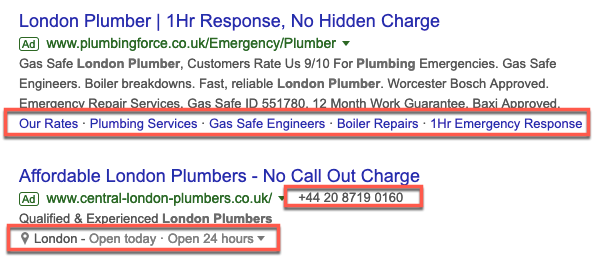
As you can see, ads with extensions contain more information.
The first example uses an extension to offer quick navigation to a few key pages on the website while the second example uses an extension to share their location and their business hours.
Google Ad extensions don’t cost anything so you have no reason not to use them. Not only will your ads stand out in the feed but you’ll also be able to add more useful information in order to sway users to take action. And many will. In fact, Google has found that ads see a 10-15 increase in click-through rates (CTR) when adding new extensions to their campaigns.
How to set up Google Ad extensions
It takes only a few minutes to set up an ad extension since all you need to do is to fill out some templates with your business information.
To get started, follow these simple steps:
- Log into your Google Ads account
- Select your campaign or ad group
- Click the “Ads & Extensions” tab on the left-hand column, then the “Extensions” tab at the top
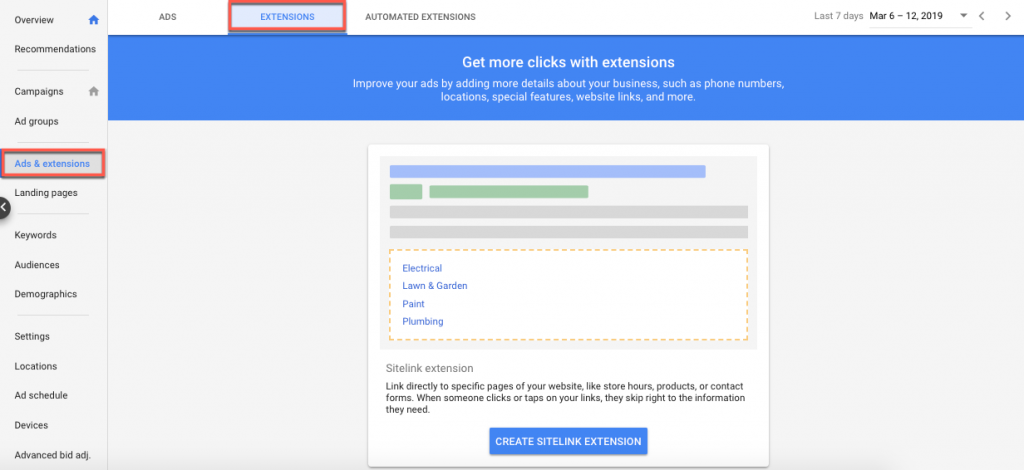
If you scroll down the page, you’ll see a “Create Ad extension” button. Click the button and on the left-side you’ll see a list with the different types of extensions you can choose from.
Hovering over each extension will show a brief description of what it does.
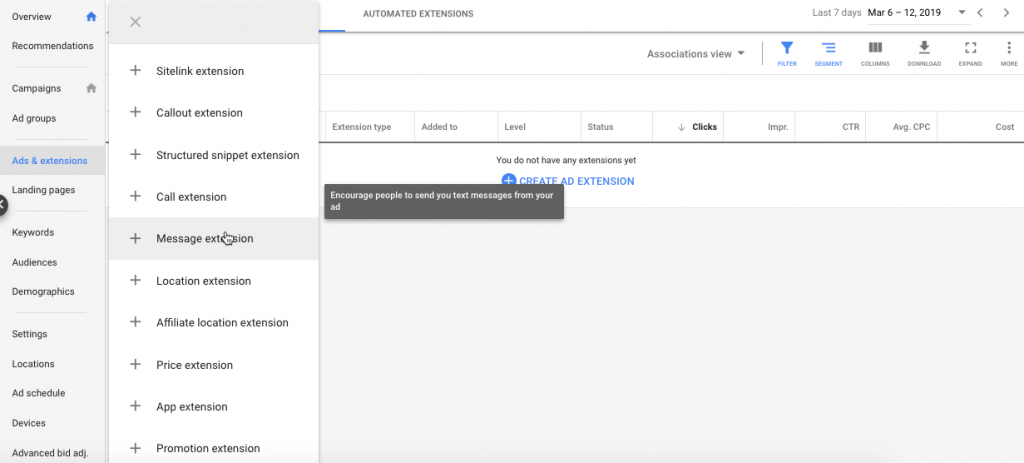
Now you just need to choose one and click the “Create” button to get started. Once you’ve created an extension, you can add it to your campaign or ad group at any point.
Now that you know what Google Ad extensions are and how to create them, let’s take a look at each and what they can do for your ad campaigns.
Seven types of Google Ad extensions you should use
- Sitelink extensions
Sitelink extensions are one of the most frequently used types of ad extensions. Why? Because they’re very useful at helping users to access the information they need quickly.
With these extensions you can add a clickable text along the bottom of your ad that sends users to specific pages on your website.
Here’s an example:

When creating sitelink extensions, you can choose to keep them simple (like in the example above), or you can take it one step further and include additional descriptive text to each link, like in this example:
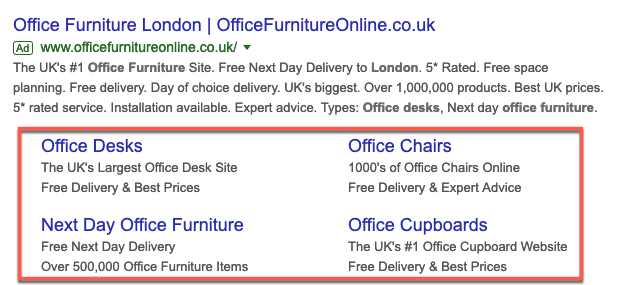
Since it takes up more space in the search results, it’s easier to stand out and grab users’ attention. Not only that but you also have more space to describe your offering and woo potential customers.
- Call extensions
Call extensions feature your business’s phone number at the top of the ad, next to the website address. This extension is very useful as it allows users to quickly get in touch with you, without having to go on your website to look for your contact information.

The call extension is particular valuable on mobile because users can simply tap the phone number to call without having to type it in.
So if someone’s using their mobile phone to look for an emergency dentist, it’s likely they have an immediate, now, not later need. The fact that they can tap on their screen to call can make the difference between whether they call you or one of your competitors.
In other words, not using this ad extension can cost you customers.
- Callout extensions
Callout extensions are different from the previous “call extensions”. They’re used to create compelling calls-to-action to entice prospects to take a specific action.
Here’s an example:

So the idea is to “callout” or highlight benefits of the products or services you’re selling, like “Customers rate us 9/10” or “1 hour response”.
You can think of them as additional bullet points or snippets of extra information that can help to entice users to click your ad instead of your competitors’.
- Structured snippet extensions
Structured snippet extensions allow you to list the specific products and services you’re selling. Rather than hyperlinks, they’re shown below your ad description in a list format preceded by a header, like in these two examples:


As is the case with sitelink and callout extensions, structured snippets can help to differentiate your business, provide additional information that’s relevant to a user’s specific search, and entice clicks from your prospects.
- Location extension
Location extensions are exactly what they sound like. They allow you to display your business’s location in the ad, letting users know exactly where they can find you. When users click the address in the ad, they’re taken to a Google map showing your location, and they can instantly get directions to where you are.
This extension is particularly useful for local businesses as it can help to drive foot traffic to your place of business, whether you own a coffee shop, a bike repair shop or a web design agency.
So if you have a brick-and-mortar location where you serve clients in person, using this extension can influence whether or not prospects decide to do business with you or one of your competitors.
Check out this example:

- Price extension
Price extensions allow you to quickly showcase how much a product or service costs. This is a great opportunity to make your ad even more competitive by providing pricing information up front.
Take this example:
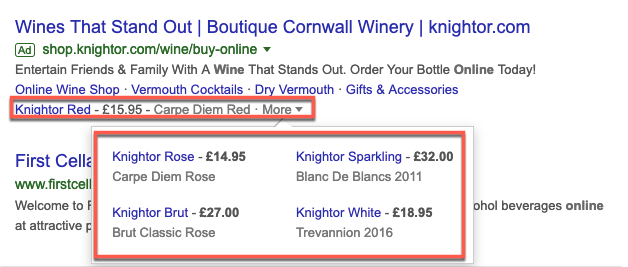
When you use it, you’ll not only attract the attention of cost-minded shoppers but also save money on irrelevant clicks since most users won’t click an ad unless that product or service is within their price range.
- Promotion extension
Everyone loves a bargain so whenever you’re running a promotion, make sure to highlight in your ad. You can easily do that with the promotion extension.
The promotions are displayed below your ad and you can also add a short description to entice users to take action. When a user click or taps on the extension, they’re sent directly to the sales page on your website.
This is a fantastic opportunity to promote your special offers and discounts, and to boost revenue so make sure you give it a try.
Take a look at this page to see the complete list of occasions and dates that are available for promotion extensions, as provided by Google.
Which one is right for your small business?
Here’s the thing: Google Ad extensions won’t cost you anything extra so there’s no reason not to use them.
Now the question is: which ad extension(s) should you use for your campaigns?
There’s no correct answer. You can experiment with all of them to see which ones work best for your small business. Depending on your ad campaign, you can even combine two ad extensions to get better results.
For example, if you’re a dentist who’s looking to attract more local customers, you can combine the call and location extensions. This allows prospects to see where you’re located and to give you a call to let you know they’re coming.
If you’re a plumber, you might choose to go with the structured snippet extensions so you can display the services you’re offering.
The only way to determine which ad extensions are right for your business is to try them out and see which ones turn more searchers into website visitors and then customers.
If you want to create highly converting Google Ad campaigns, but without the hassle, you can always give a PPC search engine management service a try.
